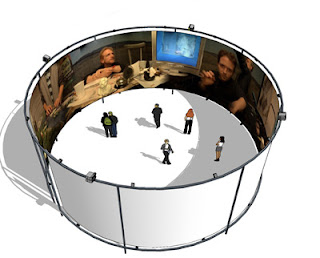
While learning about video art in class this week we have been watching and listening to videos made by "The Residents". The Residents were formed in the late 1960s and started producing music in the early 70s. They were pioneers in technology at the time and there music includes very odd, discordant melodies made with computer altered instruments and synthesizers. Even the singing in their songs is far from mainstream. Along with creating nonconventional music, they also explored video art and the creation of many music videos and performance art pieces. Never exposing their identity The Residents always wore costumes of some sort, mainly an eyeball headpiece with top hats and tuxedos. Going along with their strange public appearance their music videos were very strange and out of the ordinary. Most of the time the videos would be a performance by the band members in a costume of some sort, with wild video, lighting, and computer graphic effects. These techniques were never used by musicians before The Residents making them the first band to use music videos.
That being said, I hate "The Residents". Throughout this class I have kept an open mind about what we are shown and the artists we are learning about. I am able to find most of the artists, no matter how bizarre, interesting and I can understand how they are artistic or revolutionary regardless of my personal opinion of their work. However, I have found my limit with The Residents. I am a big music fan and I love listening to all different types of music and consider myself to have good taste and a decent ear for music. I can say now after sitting through them for two class periods, that The Residents are horrible. To me their music is not only bad but it is hard
to listen to, after watching a few of the videos in class I started to cringe each time a song came on. This awful sound is only magnified by the images that are synced to the music. The video for "It's A Man's World" was so out of the ordinary that it made the music even harder to follow and even more torturous. Overall, their lack of actual singing as opposed to speaking their lyrics, their disconnected rythms and beats, and anti-mainstream melodies make The Residents music downright annoying and unpleasant.

Now, as for Nam June Paik, or the father of Video Art; Paik is someone who I consider to be a genius. I believe it is one thing for someone to improve upon an art form or take influence from someone and vary it in some way. However, before Paik showed up, there was no such thing as video art. Paik had to discover his own art form and master it all at the same time and he did so brilliantly. Whether it was something as simple as dragging a violin behind him to decontextualize how the instrument is played, or as complex as making a tower from 200 separate TVs displaying images in a specific pattern, Paik essentially invented video art and the standard for which the art form would follow. I found Paik's work really interesting and I thought it was also interesting how he applied so much thought and knowledge in his work. He was not just throwing cool images onto TV screens, he truly understood the technology he was using and he exploited that in his work. One of my favorite works that he did was also one of his most simple; TV Buddha is a sculpture that I find really interesting because of the philosophy involved in it. The Buddha is watching himself be watched by a camera in a never-ending circuit of surveillance, however nothing will ever change since the Buddha is a statue that cannot move and the camera is only recording what the Buddha is doing. It almost sounds lame to video tape an inanimate object in this way but it makes for a result that is worth much conversation.











 Here is my flipbook, please comment.
Here is my flipbook, please comment.